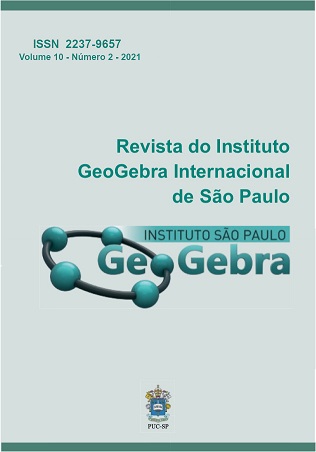The use of GeoGebra for the composition and decomposition of geometric figures: an experience with 8th grade students in the Angolan context
DOI:
https://doi.org/10.23925/2237-9657.2021.v10i2p129-146Keywords:
Mathematics Communication, Polygons, GeoGebraAbstract
The present work is the result of an experience in the classroom, carried out with students from the eighth grade of a school located in the province of Bengo in Angola. A qualitative study was developed with the purpose of analysing how students interact with GeoGebra in a first approach and verifying how the use of the software helps to help students in the composition and decomposition of polygons, as well as their classification in terms of polygons. numbers of sides. Simultaneously, it was intended to investigate how students communicate their mathematical ideas, in the context of the construction of geometric figures, through the orchestration of the class promoted by the teacher using this software. The results showed that students were able to build and consolidate concepts associated with the theme, as well as develop communication strategies in class.
References
ALMIRO, J. Os quadriláteros no Programa de Matemática do Ensino Básico: Uma reflexão sobre a prática. O professor e o Programa de Matemática do Ensino Básico, p. 175-208, 2010.
BATTISTI, S.; SCHEFFER, N. F. A utilização de TIC no ensino da matemática em escolas estaduais da cidade de Erechimrs: um diagnóstico. XII Encontro Nacional de Educação Matemática, p. 1-10, 2016.
CABRITA, I. m@ c1 em@ c2–Programa de Formação Contínua em Matemática com Professores do Ensino Básico. Currículo e Tecnologia Educativa, v. 2, n. 8, p. 231-264, 2008.
CANAVARRO, A. P . Ensino exploratório da Matemática: Práticas e desafios. Educação e Matemática, n. 115, p. 11-17, 2011.
COELHO, A. J. A. GeoGebra e iTALC numa abordagem criativa das isometrias. 2013. Tese de Mestrado. Universidade de Aveiro. Disponível em: http://hdl.handle.net/10773/12422 . Acesso em: 20 nov. 2021.
DUARTE, J. Tecnologias na educação matemática: As TIC e o Novo Programa de Matemática do Ensino Básico. Educação e Matemática, n. 105, p. 80-82, 2009.
GUERREIRO, A. Comunicação no ensino-aprendizagem da matemática: Práticas no 1. º ciclo do ensino básico. 2011. Tese de Doutorado. Universidade de Lisboa. Disponível em: http://hdl.handle.net/10400.1/3767 . Acesso em: 20 nov. 2021.
INIDE-MED. Programas de Matemática 7ª, 8ª e 9ª classe – 1º Ciclo do Ensino Secundário. Luanda: Editora Moderna. 2019.
KING, J.; SCHATTSCHNEIDER, D. Geometria dinâmica. Selecção de textos do livro Geometry Turned On!. APM. Lisboa, 2003.
LAGRANGE, J.-B. Innovations technologiques dans l’enseignement des mathématiques: paradigmes et changement de la professionnalité de l’enseignant. Quadrante, [S. l.], v. 18, n. 1&2, p. 29 a 52, 2009. DOI: 10.48489/quadrante.22841. Disponível em: https://quadrante.apm.pt/article/view/22841 . Acesso em: 20 nov. 2021.
MARTIN, W. G. Principles and standards for school mathematics. National Council of Teachers of, 2000.
MELO, H. F. S. A Matemática num contexto de Projecto Educativo: Evolução, estruturação, criatividade, ensino e objectividades. Educação e Matemática, n. 116, p. 8-11, 2012.
MERCADO, L. P. L.. Novas tecnologias na educação: novos cenários de aprendizagem e formação de professores. Reflexões sobre conhecimentos e Educação. Maceió: EDUFAL, 2000.
NATIONAL COUNCIL OF TEACHERS OF MATHEMATICS (NCTM). Princípios para a ação: assegurar a todos o sucesso em matemática. Portugal: Associação de Professores de Matemática. 2017.
NETO, T.; BREDA, A.; GODINO, J. Desenvolvimento do raciocínio dedutivo ao nível do ensino secundário: recurso a geometrias planas. Quadrante, [S. l.], v. 20, n. 1, p. 83–100, 2011. DOI: 10.48489/quadrante.22858. Disponível em: https://quadrante.apm.pt/article/view/22858 . Acesso em: 20 nov. 2021.
Partnership for 21st Century Skills. (2014). Framework for 21st century learning. http://www.p21.org/our-work/p21-framework
PINTO, E.; CANAVARRO, A. P. O papel das representações na resolução de problemas de Matemática: um estudo no 1. º ano de escolaridade. 2012.
PONTE, J. P. da; et al. Programa de Matemática do Ensino do Ensino Básico. Lisboa: Ministério da Educação, Direcção Geral de Inovação e Desenvolvimento Curricular. 2007
PONTE, J. P. Gestão curricular em Matemática. O professor e o desenvolvimento curricular, p. 11-34, 2005.
PONTE, J.P. Práticas profissionais dos professores de Matemática. (Org.). Lisboa: Instituto de Educação da Universidade de Lisboa. 2014.
RIBEIRO, A. O Cabri-Géomètre e a construção de uma nova cultura matemática–um estudo no âmbito da formação inicial de professores do 1º CEB. 2005. Tese de Doutorado. Universidade de Aveiro. Disponível em: http://hdl.handle.net/10773/1474 . Acesso em: 20 nov. 2021.
ROCHA, G.; SEGURADO, I.; CAPELA, M. O perímetro com recurso ao GeoGebra. O Professor e o Programa de Matemática do Ensino Básico, p. 121-138, 2010.
SERRAZINA, Lurdes; OLIVEIRA, Isolina. Trajectórias de aprendizagem e ensinar para a compreensão. O professor e o programa de matemática do Ensino Básico, p. 43-59, 2010.
SILVEIRA, A. P. R. O GeoGebra como ferramenta de apoio para aprendizagem significativa da Geometria. Revista do Instituto GeoGebra Internacional de São Paulo, [S. l.], v. 7, n. 1, p. 07–30, 2018. Disponível em: https://revistas.pucsp.br/index.php/IGISP/article/view/34778 . Acesso em: 20 nov. 2021.
VELOSO, E. et al. Normas para o currículo e a avaliação em matemática escolar. Portugal: Associação de Professores de Matemática. 1991.
VYGOTSKY, Lev Semenovich; COLE, Michael. Mind in society: Development of higher psychological processes. Harvard university press, 1978.
Downloads
Published
How to Cite
Issue
Section
License
Copyright (c) 2021 Revista do Instituto GeoGebra Internacional de São Paulo

This work is licensed under a Creative Commons Attribution 4.0 International License.
Submission, processing, and publication of articles sent to the journal and registration of the DOI at Crossref is free of charge.
Authors retain their copyright and grant the journal the right of first publication of their article, which is simultaneously licensed under a Creative Commons - Attribution 4.0 International license CC BY that allows others to share the article by acknowledging its authorship and initial publication by the journal.
The GeoGebra journal encourages its authors to register their work with information and communication management systems aimed at researchers, such as Academia.edu, Mendeley, ResearchGate, etc.


 10.23925
10.23925
